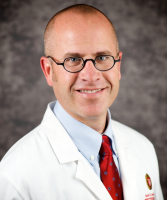Dr. David Andes speaks to audience of thousands about antimicrobial drug discovery writ large


While speaking on a corporate campus with a cluster of buildings named Wizard's Academy, an infectious disease expert told developers of an electronic health records system that maintaining a robust arsenal of antibiotics is going to take some magic.
"For every antimicrobial drug we use, it's not a matter of if pathogens will become resistant to it, it's just a question of when," said David Andes, MD, professor and head, Infectious Disease.
Dr. Andes had been invited to deliver a presentation to Epic Systems members during an all-staff meeting attended by 7,500 employees. He illustrated how the availability of the first commercially produced antimicrobials in the 1940s had transformed the practice of medicine, describing a 1943 case study of a young girl who arrived at the hospital moribund (near death) due to a rapidly spreading facial infection that impeded swallowing and breathing. "After 14 days of treatment with penicillin, she survived-and lived into her 70s," he said.
Antibiotics also enable medical interventions that otherwise would be impossible, such as organ transplantation and prevention of infections in vulnerable individuals such as immunocompromised cancer patients, people undergoing complex surgery, and premature infants lacking a fully developed immune system.
But bugs continually outwit drugs, and the average length of time between introduction of a new antimicrobial drug and the first report of pathogen resistance to is a mere 10 years. This is a growing problem in the United States: deaths due to antibiotic resistance currently claim more than 23,000 lives per year with a $2B economic toll. If unchecked, these numbers are projected to rise to more than 50M deaths and $100T in costs by 2050.
Combatting antibiotic resistance requires a four-pronged approach, explained Dr. Andes: infection prevention and control, tracking outbreaks, wise use of antibiotics (termed "stewardship,"), and developing new drugs. Toward that end, Dr. Andes and colleagues have taken an unconventional approach: taking advantage of chemical warfare that occurs in nature.
Working with entomologist Cameron Currie, PhD, professor, Department of Bacteriology, Dr. Andes and a team of chemists, evolutionary and developmental biologists, fungal microbiologists, bacteriologists, and entomologists are mining the symbiotic relationships that exist as long-term interactions between two or more different biological species. "For example, one system involves an ant, a helpful fungus that grows on the ant's body and actually bathes it in antibiotics that protect it against a disease-causing microbe," he explained.
Such relationships have an ancient evolutionary history-which means the chemical compounds involved have been associated with the host organisms for millions of years. "That's a good thing, because these compounds are more likely to have a good safety profile for humans," said Dr. Andes. So the team is systematically identifying chemical compounds in these bugs-on-bugs colonies and testing them for antimicrobial activity and toxicity in cellular and mouse assays.
So far, the gamble has proven successful beyond the group's wildest dreams. "Our initial studies identified more than 10,000 novel molecules from fewer than 200 symbiotic antibiotic-producing strains," said Dr. Andes. That success rate is 100-fold to 1000-fold higher than conventional industrial screening approaches, such as interrogating soil samples for antimicrobial compounds.
"I really enjoyed Dr. Andes’ presentation," said Matt Pap, who is a member of the Implementation Services group at Epic Systems.
"He highlighted the diminishing ability to treat infections due to antibiotic resistance. It is critical we work with the Epic community to implement antimicrobial stewardship tools that support responsible use of the limited antimicrobial medications we have today. At the same time, Dr. Andes and his team offer hope for novel antimicrobials to combat drug resistant organisms. It was especially interesting to hear about that research occurring with natural compounds instead of lab synthesis.”
And the team is just getting started. Members of the Wisconsin Antimicrobial Drug Discovery Research Center have collected more than 2,400 host species from land and sea (in addition to insects, they are also focusing on marine species such as sponges that exist in symbiosis with microbes). From these hosts, they've collected more than 18,000 microbial strains, screened 200 microbes, identified more than 400 compounds with antimicrobial activity, and found more than 80 candidates for new antibiotic drugs based on in vitro and in vivo assays.
"It takes a multidisciplinary team," said Dr. Andes. And perhaps, one might say, even a bit of magic.
Editor's Note: Dr. Andes' talk was one of three invited presentations by Department of Medicine faculty members to Epic Systems employees during the 2017-18 academic year.
Resources:
- "Dr. Vincent Cryns presents on UW-Madison cancer and obesity research to more than 7,500 employees at Epic," Department of Medicine, October 19, 2017
Photo courtesy of Epic Systems